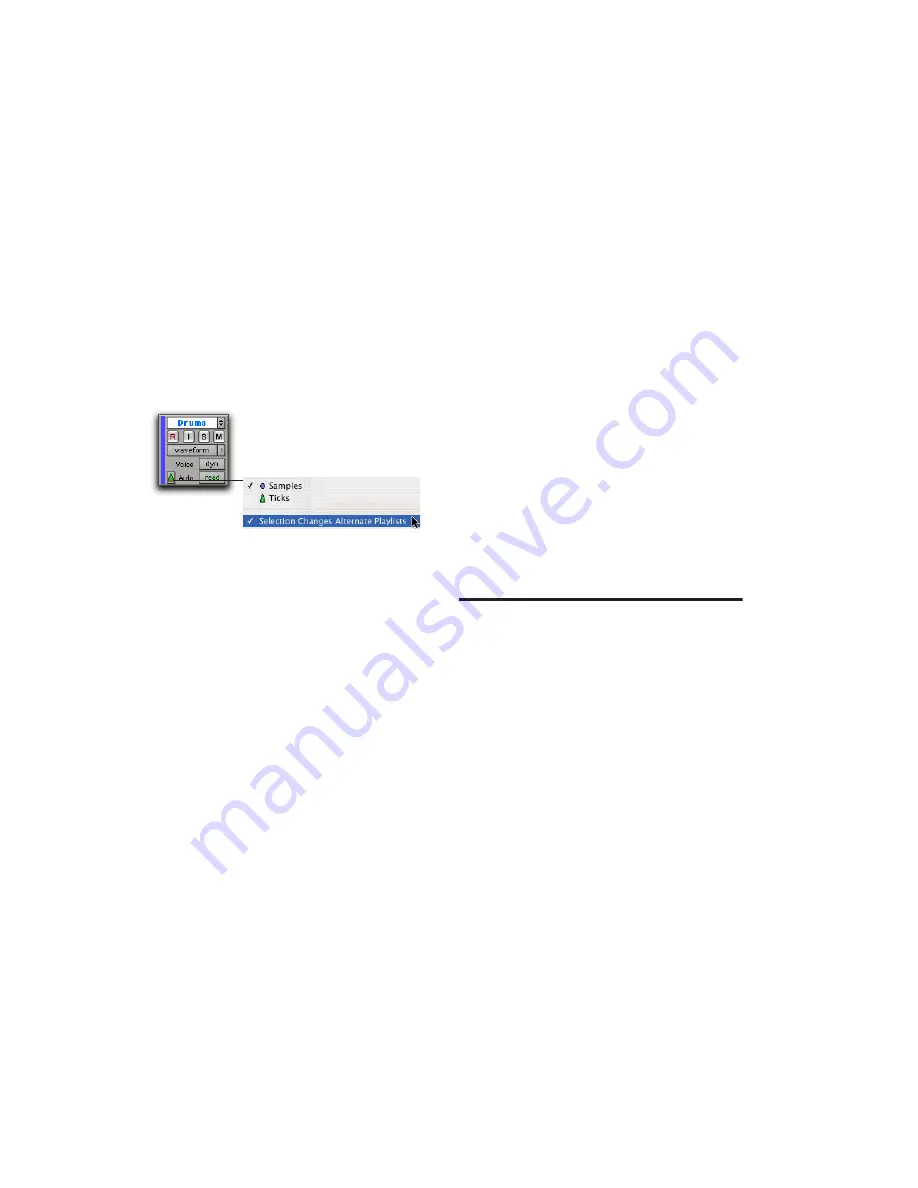
Pro Tools Reference Guide
352
Alternate Playlist Timebases
When you change a track’s timebase, you can
choose to apply the timebase change to the ac-
tive Playlist on that track only, or to that track
and all the alternate playlists for that track.
To configure a timebase change to affect
timebases of all playlists in a track:
■
Click the Timebase selector and enable the
“Selection Changes Alternate Playlists” option.
Groups
When you change the timebase for an audio
track that is part of an active group, all the tracks
in the group will change to the same timebase.
Audio Region Location
In tick-based audio tracks, the location of an au-
dio region is determined by the region’s start
point, unless the region contains a sync point.
If the region contains a sync point, the sync
point determines where the audio region is
fixed to the grid.
Marker Location
When creating markers and Selection Memory
Locations, you can specify whether they have
an Absolute (sample-based) or Bar|Beat (tick-
based) reference. For more information, see
“Bar|Beat and Absolute Reference” on page 525.
Sample Rounding and Edit Operations
When audio material in Pro Tools is sample-
based, some amount of sample-rounding may
occur with some edits when the Main Time
Scale is set to Bars|Beats. This is most evident
when you need audio regions to fall cleanly on
the beat (as when looping) and notice that the
material is sometimes a tick or two off. With a
few simple precautions, this can be avoided.
When selecting audio regions to be copied, du-
plicated, or repeated, make sure to select the ma-
terial with the Selector tool (enable Grid mode
for precise selections), or set the selection range
by typing in the start and end points in the
Event Edit area. Do not select the material with
any of the Grabber tools (or by double-clicking
with the Selector tool). This ensures that the se-
lection is precise in terms of the grid (and not
based on the length of the material in samples).
Playlists
The ability to create
playlists
is a powerful fea-
ture of Pro Tools. Each track maintains a “main”
playlist and any number of “alternate” edit play-
lists.
Edit playlists
let you take a snapshot of a track’s
current arrangement of regions, thereby freeing
you to experiment with alternate arrangements,
returning as necessary to previously saved play-
lists.
A playlist, which can consist of a single region or
many regions, can only be assigned to a track if
it is not in use by another track. While you can
create an almost unlimited number of edit play-
lists, which are shared among all tracks, each
track has its own set of dedicated
automation
playlist
s.
Timebase selector and pop-up menu
Summary of Contents for Pro Tools
Page 1: ...Pro Tools Reference Guide Version 7 3 ...
Page 15: ...1 Part I Introduction ...
Page 16: ...2 ...
Page 33: ...19 Part II System Configuration ...
Page 34: ...20 ...
Page 44: ...Pro Tools Reference Guide 30 ...
Page 94: ...Pro Tools Reference Guide 80 ...
Page 95: ...81 Part III Sessions Tracks ...
Page 96: ...82 ...
Page 108: ...Pro Tools Reference Guide 94 ...
Page 130: ...Pro Tools Reference Guide 116 ...
Page 269: ...255 Part IV Recording ...
Page 270: ...256 ...
Page 310: ...Pro Tools Reference Guide 296 ...
Page 345: ...331 Part V Editing ...
Page 346: ...332 ...
Page 402: ...Pro Tools Reference Guide 388 ...
Page 496: ...Pro Tools Reference Guide 482 ...
Page 548: ...Pro Tools Reference Guide 534 ...
Page 571: ...557 Part VI MIDI Editing ...
Page 572: ...558 ...
Page 596: ...Pro Tools Reference Guide 582 ...
Page 637: ...623 Part VII Mixing ...
Page 638: ...624 ...
Page 702: ...Pro Tools Reference Guide 688 ...
Page 771: ...757 Part VIII Video Sync Surround ...
Page 772: ...758 ...
Page 792: ...Pro Tools Reference Guide 778 ...
Page 806: ...Pro Tools Reference Guide 792 ...
Page 856: ...Pro Tools Reference Guide 842 ...






























